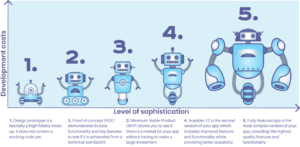How Much Does It Cost To Develop An App In Australia
At the moment it costs anywhere between $30,000 and $250,000 to develop an app in Australia. This may seem like a ridiculously broad range, however, there are a few key factors that import the costs of your app development.
Contact us for the more details
Australian app development in a nutshell
In this day and age, we are more dependent on our phones than ever before. Apps have become part of our daily routines, from using your apple wallet to pay for your iced caramel latte to using google maps for directions to that new funky restaurant. I mean when was the last time you whipped out an actual physical map to look up directions.
The increased use of apps has given businesses new ways to connect with their customers and increase their brand awareness. By creating unique and innovative apps, businesses are able to set themselves apart from their competition.
App development is the talk of the town. Which is why we wanted to give you an in-depth understanding of the costs involved with developing an app in Australia. Understanding the costs associated with developing your app can help you make well-informed decisions and keep your project on track and within budget.
Behind the Price Tag – Key Factors Impacting App Development Costs
The costs of developing your app can vary widely depending on the following factors; the platform (iOS vs. Android), the design’s complexity, the key features and functionality, and the app’s level of sophistication. Other factors to keep in mind which impact the costs are the location of the app development and maintenance and ongoing support.
Platform (iOS vs. Android) –
One of the biggest factors that impacts the cost of your app development is the choice of platform, iOS and/or Android. As each platform is written in their own programming language, building an app that supports both platforms will require more work and therefore incur a higher price tag.
If coding natively, you will need to build the front end of the app in both Java and Swift/Objective C to support each platform. Alternatively, you can choose to use React Native. Your developers no longer have to build the same app from scratch for different operating systems. React Native allows them to repurpose the code and export it as a native app for each platform. This could be a cost saving solution as the front end app development has effectively been cut in half, resulting in a faster development phase.
Design complexity –
The complexity of your app’s design has a big impact on the development costs. Developing an app with a simple, straightforward interface will generally cost much less than one with a complex user interface and multiple screens. Basically, the more complex your app’s design, the more time and effort it takes to create and implement it.
Generally speaking there are two types of apps, high complexity and low complexity apps. High complexity apps like Instagram, Facebook, Uber, Spotify and Up Bank are more expensive to develop. Whereas low complexity apps like QR scanners, notes and calculator apps are less expensive to develop.
Features and functionality
Another major factor is the complexity of the features and functionalities of your app. The more complex or advanced the features, the higher the costs will be. For example, a simple calculator as a feature will cost you less than the likes of a social feed algorithm. Therefore it is important to carefully consider which features are truly essential to your app’s success.
Level of sophistication –
Typically, apps will go through different phases as they grow and evolve. The cost varies significantly depending on the phase the app is in. As the app grows, the level of sophistication increases, requiring more advanced features, higher functionality, user interface, user experience and scalability.
For example, typically a startup’s first release will be a proof-of-concept app. This is a basic, lower cost version used to ensure that it is a viable idea before investing further.
The design prototype like UI/UX design and proof-of-concept phases have lower development costs compared to the MVP, scalable V2, and fully-featured app phases. As they require more advanced features, higher functionality, user interface, user experience, and
Location of app development –
The country in which your app is being developed has a big impact on the costs of your app, due to the difference in cost of labour. The costs of labour are relatively high in Australia, which is likely to be reflected in the cost of development. However tempting it might be to send your project overseas, it’s important to base your decision on a company’s expertise and quality of work, rather than its location and pricing.
Maintenance and ongoing support –
Lastly, it is important to consider the costs of ongoing maintenance and support. Once your app is launched, you will likely need updates and bug fixes to ensure your app remains functional and up to date.
Besides your basic maintenance costs, you may need ongoing support if you want to implement improvements and make changes based on feedback of your app. The cost of this depends on the complexity of the updates you wish to make. We recommend setting at least 10% of your total budget aside for maintenance and ongoing support once your app has been launched.

Breaking it Down: What You Can Expect App Development Cost
Besides design and programming costs, you will also need to account for the app development costs. We’ve summed up a few of the main costs to keep in mind; server fees, developer account subscriptions, digital marketing expenses and third-party services.
Server fees
Server fees are the costs you incur for using and maintaining the server infrastructure which supports your app. It is responsible for storing, processing and transmitting your user data. It is important to ensure that server infrastructure is designed and implemented efficiently as it impacts your app’s performance, reliability and scalability. Server fees are anywhere from $10 to $10,000 per month depending on the size of your user base and the complexity of services you provide.
Developer accounts
In order to release your app on the Apple and/or Google play store you will need to create a developer account and subscribe to their developer programs. Both Google and Apple charge a fee for creating an Developer account. Google has a one-time $38 fee whereas Apple charges a $150 annual subscription fee. There are a few benefits of having a developer account, such as access to app store distribution, developer tools and resources, and technical support.
Marketing
No matter how to make an App technically and visually appealing , if no one is aware of its existence, it won’t be successful. Marketing can help you increase brand awareness, build user engagement, and drive user acquisition. However, it comes with a price tag, the costs are dependent on your marketing strategy and the industry of your app. Marketing allows your app to stand out in the overcrowded app marketplace.
Third party services
Third party services can provide functionality and services that would be difficult and costly to develop yourself. By integrating third party services, you can improve functionality and user experience whilst reducing development time and costs. It is important to factor in the third party service costs as many have subscription and/or usage fees.

Tips for reducing app development costs without compromising quality
As previously mentioned, developing an app can cost anywhere from $30,000 to $250,000. Costs can quickly spiral out of control if your app is not managed effectively. We’ll share our tips for reducing app development costs without compromising quality.
Define clear requirements
It is important to clearly outline your app’s key requirements, functionality and technical specifications. This should help you avoid costly revisions and updates later in the development process.
Use agile development methodologies
Using Agile methodologies allows you to break your development process down into small, iterative sprints. Which allows your developers to focus on specific features and functionality, which can result in delivering higher quality in shorter periods. Agile methodologies such as Scrum and Kanban can help you achieve a high quality end product whilst reducing development time and costs.
Hybrid app development
The use of Hybrid app development allows your developers to use a single codebase for both Android and mobile app, reducing the development time. Thereby being a cost effective alternative to native app development. Furthermore it ensures a consistent user experience across the different platforms and devices.
Use third-party services
Third-party services allow you to use functionality and services which would be difficult and costly to be developed. It provides you with the ability to still provide high quality services on your app whilst reducing your development costs.
Test early and often
Once your app is released it is more expensive and harder to fix issues, which is why it is helpful to catch any bugs early on. Regularly testing throughout the development process allows you to identify issues and bugs ahead of the release, improving the quality and functionality of your app.
App development is expensive, no matter how you look at it. As previously explained, the more complex your app is, the higher these costs will be. If you are after building a calculator, the price tag for the design, development and programming costs is significantly lower than building a social media platform. However, you are able to avoid unexpected budget blowouts by using a strategic approach and using the above mentioned tips.
If you are looking for a team of App developers, we would love to talk to you! It is important to us to involve you every step of the way to ensure the project is as stress free as possible. Our agile work method involves setting various milestones and use reviews and feedback at each stage to make sure the project stays on track and in line with your requirements.